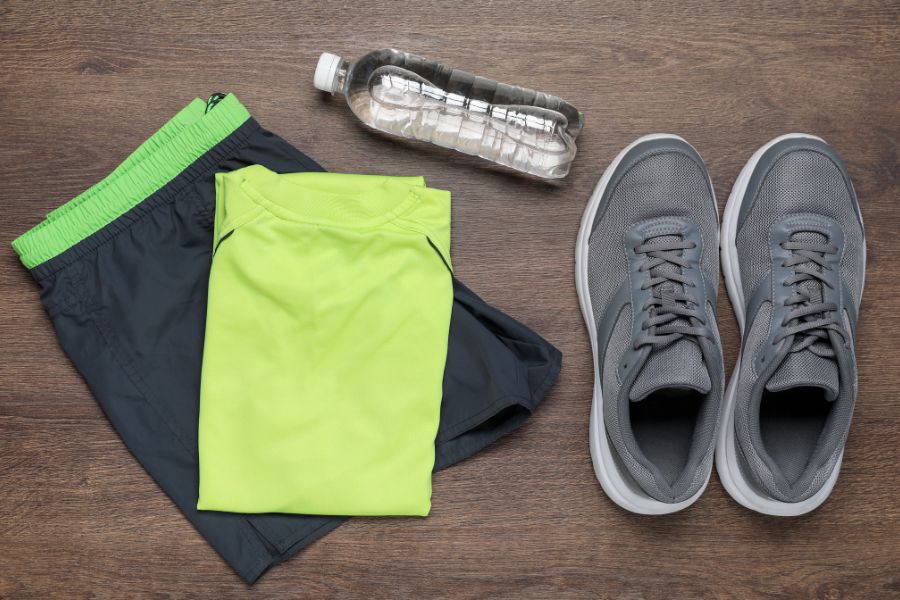How many steps do you really need each day to stay healthy?
According to leading fitness professionals, the number isn’t as important as the consistency, variety, and joy behind your movement.
The experts below share simple, science-backed ways to build sustainable daily habits that improve strength, balance, and overall health—without obsessing over a specific step count.
Combine Varied Movement for the Greatest Health Benefits

The “10,000 steps a day” goal isn’t a scientific benchmark—it originated from a 1960s marketing campaign in Japan.
That said, it can still serve as a useful, easy-to-remember target that encourages people to move more throughout the day.
From a health and performance perspective, research shows that benefits like improved cardiovascular health, lower mortality risk, and better blood sugar control start showing up well below 10,000 steps.
For most people, 6,000 to 8,000 steps per day provides measurable improvements in health markers, especially when paired with regular resistance training and mobility work.
The real takeaway is consistency and variety. Walking is an excellent baseline activity, but movement quality and intensity matter, too. A combination of daily walking, strength training, and mobility work will deliver far greater long-term health benefits than simply chasing a step count.
Brian Murray, Founder, Motive Training
Create a Personal Rhythm of Motion

I’ve never believed that step counts reflect the whole story. Health isn’t measured by numbers—although we do love to quantify many! It’s built through strength, balance and steady motion.
Our bodies were designed to move, but we’ve engineered much of that movement out of daily life.
Whether it’s swimming, biking, or simply finding short, intentional moments to move, each one makes a difference.
A stretch routine before coffee or a short walk after dinner might seem small, but they add up.
New research backs what we see every day: consistent, intentional movement keeps energy and mobility strong.
In the end, it’s not about counting steps—it’s about creating a rhythm of motion that carries you through life.
Linda T Gottlieb, Fitness Coach and Motivator, FIT Training LLC
Prioritize Joyful Movement in Daily Routines

In my experience, aiming for 10,000 steps is a great motivator, but it’s definitely not the magic number for everyone.
What matters more is finding ways to move often and consistently throughout the day—whether that means a lunchtime walk in the garden, dancing while you cook, or playing with your kids.
I always encourage my clients to focus less on reaching a specific step count and more on building joyful movement into their daily routines—it’s the consistency and enjoyment that make the real difference.
Livia Esterhazy, Owner, The Thrive Collective
Balance Walking with Strength and Recovery

10,000 steps is a nice goal, but it’s not how we should measure health. That number gained popularity by being simple to sell, not because it’s ideal for everyone. What actually counts is moving enough each day to keep your heart strong, joints limber, and muscles working.
In my office, I don’t just count steps; I examine gait, posture, and joint stress. A person may achieve 10,000 steps with poor form and feel worse, while another who takes 6,000 quality steps and adds mobility exercises may feel far better.
Walking is great, but resistance exercise completes the picture. Muscles and bones need progressive overload—squats, lunges, push-ups, and pulling exercises—to maintain strength and stability as we age. Many of my clients who walk regularly still experience back pain or weakness until they add strength training. Once they do, they become more confident and capable.
Recovery is equally vital. Your body needs time to repair tissues and adapt for durability. Recovery is about doing less, not more—allowing your body to rebuild and grow stronger.
- 6,000–8,000 quality steps with good posture
- 20–30 minutes of strength training several times a week
- Recovery habits like stretching, sleep, and circulation work
That balance helps people move well, stay pain-free, and build lasting power for the long run.
Alex Lee, Co-Founder, Physiotherapist and Fitness & Recovery Expert, Saunny
Aim for 7–8K Steps with Daily Consistency

10,000 steps a day is a good goal to shoot towards on a daily basis; however, not everyone has the ability to get that many steps in a day, especially if they work in a job that requires sitting.
For that reason, I believe 7–8,000 steps is more achievable and is a better benchmark to aim for as long as there is daily consistency.
Consistency is where most people fail because they don’t see any results or feel any different right away, but as the old saying goes, trust the process and you’ll get the most benefits out of walking.
You can accomplish a lot by walking 8,000 steps a day, adding some form of resistance training 2–3 times a week, and eating a balanced diet where you avoid fast food 80% of the time.
Jose Guevara, Fitness Instructor / Home Gym Equipment Tester, ShreddedDad.com
Build Step Goals Based on Current Activity

As a wellness coach, I believe the 10,000 steps guideline can be useful, but it’s not a one-size-fits-all benchmark. Everyone’s body, lifestyle, and fitness level are different.
For some, 10,000 steps may be too ambitious; for others, it’s way too easy.
A more sustainable approach is to look at where you are now and build gradually.
For instance, if you’re currently averaging 5,000 steps a day, try setting a goal of 6,000 steps for the next month.
Once that becomes consistent, increase by another 1,000 steps. This progressive method helps create lasting habits without overwhelming yourself.
Ultimately, the best target is one that supports your goals, fits your lifestyle, and keeps you moving forward.
Silvija Meilunaite, Nutrition and Wellness Coach, Founder, Barefoot Basil
Focus on Movement Quality Over Step Count

While the 10,000 steps benchmark has become widely accepted, many people either obsess over hitting this number or feel defeated when they fall short.
In my practice as a senior rehabilitation specialist, I regularly explain that this figure originated as a marketing tactic rather than a scientific threshold. Instead of pursuing an arbitrary number, I encourage focusing on consistency and quality of movement throughout your day.
Research shows that 7,000–8,000 steps can significantly reduce lifestyle disease risks and mortality rates.
For genuine physiological benefits, consider aiming for 30–45 minutes of walking in Zone 2—where conversation is still possible but singing becomes difficult.
This typically falls between 60–70% of your peak heart rate (calculated using the common formula: 220 minus your age). This heart rate range supports cardiovascular endurance and optimizes fat metabolism.
I suggest integrating walking naturally into your daily routine: break up sitting periods with short walks, practice mindful walking outdoors, or combine walking with breathwork or light mobility exercises to enhance both physical and mental wellbeing. The true goal isn’t reaching a specific step count but moving with purpose.
Walk regularly, walk well, and make movement an integral part of your daily life—that’s the foundation of lasting health.
Garima Gaur, Senior Rehabilitation Specialist
Conclusion
While 10,000 steps a day might make for an easy slogan, the experts agree: there’s no magic number for good health.
What truly matters is daily consistency, movement quality, and variety.
Whether it’s walking, lifting, stretching, or playing with your kids, the goal is simple—move with purpose, move often, and move in ways that make you feel good.
That’s the real secret to long-term health.

Leave a Reply